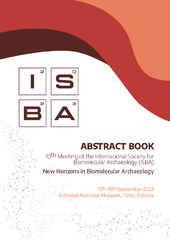Приказ основних података о документу
Tracing the early spread of domestic cat in Central Europe: Human-mediated dispersal or natural introgression?
| dc.creator | Krajcarz, Magdalena | |
| dc.creator | Krajcarz, Maciej | |
| dc.creator | Bielichová, Zora | |
| dc.creator | Bulatović, Jelena | |
| dc.creator | Csippán, Péter | |
| dc.creator | Dimitrijević, Vesna | |
| dc.creator | Марковић, Nemanja | |
| dc.creator | Živaljević, Ivana | |
| dc.creator | Makowiecki, Daniel | |
| dc.creator | Baca, Mateusz | |
| dc.date.accessioned | 2024-01-04T16:51:44Z | |
| dc.date.available | 2024-01-04T16:51:44Z | |
| dc.date.issued | 2023 | |
| dc.identifier.uri | http://rai.ai.ac.rs/handle/123456789/1377 | |
| dc.description.abstract | Despite significant progress in paleogenomics and the increasing amount of new data on animal domestication, we still know little about the history of cats. Until now, it was known that only one subspecies, the Near Eastern wildcat (Felis silvestris lybica), was domesticated. The domestication area was assumed to be the Near East during the Neolithic period, with a prominent role in ancient Egypt. From this region, the cats spread through the Mediterranean and beyond. It has been accepted that the primary role in the expansion of cats through northern Europe was that of the Roman legions. However, we found that cats that carried mitochondrial DNA (mtDNA) haplotypes of wildcats from the Near East were present in Central Europe already in the Neolithic, much before Roman times. This indicates that the cats' route from the domestication centers to Central Europe might have been more complex than previously thought and could have been related to the Neolithic expansion. Our new results reveal the presence of the mtDNA haplotypes of the Near Eastern wildcats in Poland even in the pre-Neolithic period. This may suggest that the Near Eastern wildcats could spread across Europe independently of the expansion of farming, and, in consequence, the natural range of the Near Eastern wildcat could have been much broader than previously assumed. To understand how and when domestic cats appeared in Central Europe, we perform a target enrichment of ca. 57,000 genomic SNPs. We believe that it will allow us to finally determine whether the appearance of the Near Eastern wildcat mtDNA in Central Europe was a natural admixture between two subspecies or was human-mediated dispersal of tamed/domesticated cats. The study is supported by the National Science Centre, Poland, grant no. 2019/35/B/HS3/02923. | sr |
| dc.language.iso | en | sr |
| dc.publisher | Estonian National Museum, Tartu, Estonia | sr |
| dc.rights | openAccess | sr |
| dc.source | Book of Abstracts : 10th Meeting of the International Society for Biomolecular Archaeology (ISBA) New Horizons in Biomolecular Archaeology | sr |
| dc.subject | paleogenomics | sr |
| dc.subject | animal domestication | sr |
| dc.title | Tracing the early spread of domestic cat in Central Europe: Human-mediated dispersal or natural introgression? | sr |
| dc.type | conferenceObject | sr |
| dc.rights.license | ARR | sr |
| dc.citation.spage | 164 | |
| dc.identifier.fulltext | http://rai.ai.ac.rs/bitstream/id/2404/Tracing_the_early_spread_of_domestic_cat.pdf | |
| dc.identifier.rcub | https://hdl.handle.net/21.15107/rcub_rai_1377 | |
| dc.type.version | publishedVersion | sr |


